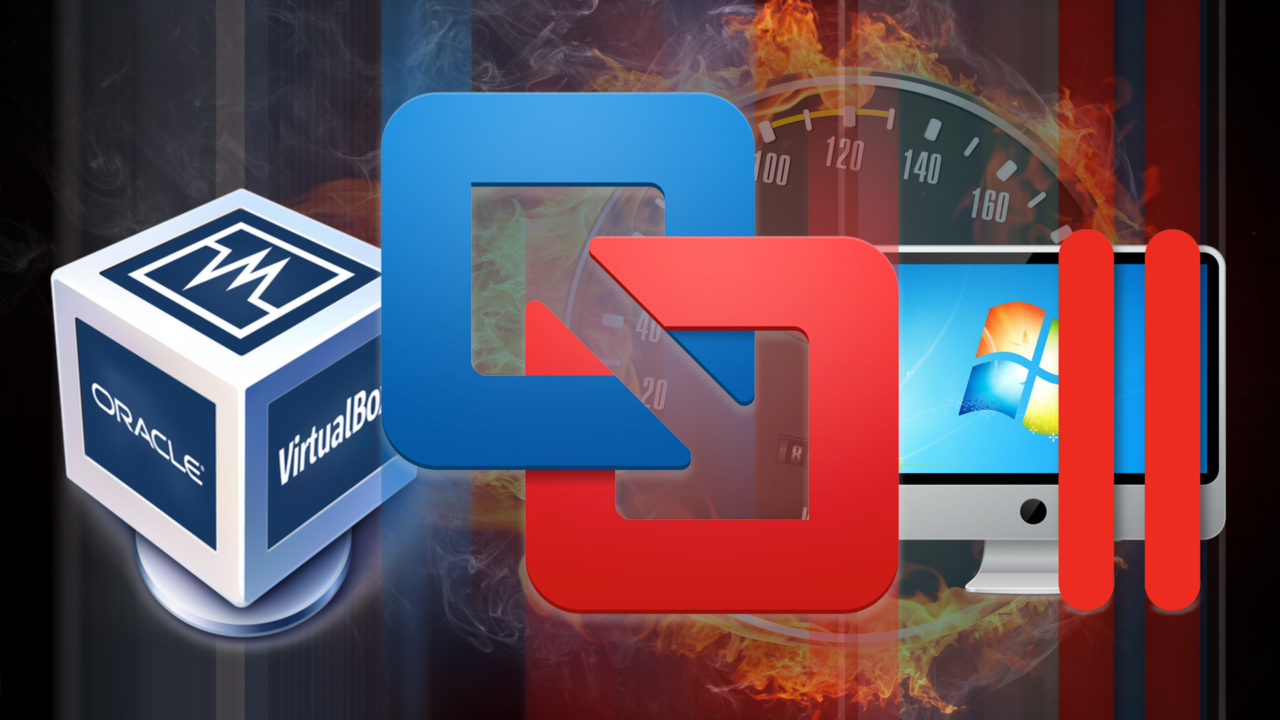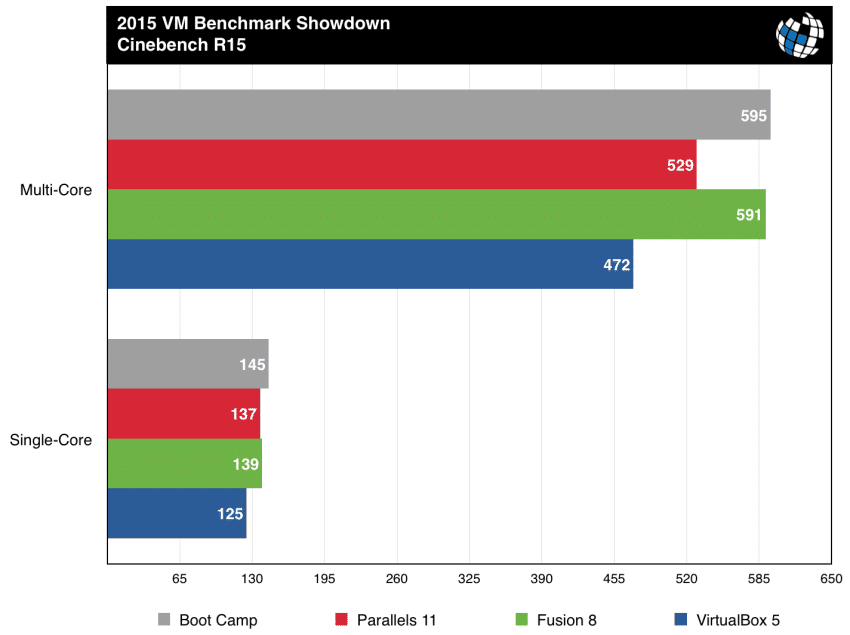2015 VM Benchmarks: Parallels 11 vs. Fusion 8 vs. VirtualBox 5

Cinebench R15
We continue our Parallels 11 vs. Fusion 8 benchmarks with a look at the latest version of the Cinebench test. Based on the powerful Cinema 4D animation software, Cinebench R15 is a cross-platform benchmark that tests a computer’s 3D rendering capabilities.
Cinebench looks at three primary categories: multi-thread CPU rendering, single-thread CPU rendering, and OpenGL 3D performance. There’s a problem with that last category, however, as there’s a bug in Fusion 8 that produces abnormally low results, and the resulting score of the test is not indicative of actual OpenGL performance. We’ve asked VMware about this bug and they told us that their priority for this release was to optimize OpenGL performance for productivity applications, but they’re investigating the cause of the issue in Cinebench. While we don’t think that this Cinebench bug as it stands today is an indictment of Fusion’s potential overall, it does suggest that users who are interested in OpenGL rendering via apps like Cinema 4D may wish to test performance via the Fusion and Parallels free trial programs to ensure adequate performance with their required apps.
All of that said, the CPU-based rendering tested by Cinebench performed without issue in all platforms. The scores in the chart below are based on comparative Cinebench “points,” with a higher number indicating better performance.
All virtualization platforms score relatively well in single-core rendering, and Parallels and Fusion are within 5 percent of native performance. When it comes to multi-core rendering, however, Fusion 8 again scores extremely close to native performance, while Parallels isn’t quite as efficient and falls about 10 percent short. As we saw earlier in the Geekbench tests, VirtualBox just can’t compare to its commercial competitors when it comes to multi-core efficiency, and trails Fusion by about 20 percent.
Table of Contents
[one_half padding=”0 5px 20px 0″]
1. Introduction
2. Test Setup & Methodology
3. Geekbench
4. 3DMark
5. FurMark OpenGL
6. Cinebench R15
7. PCMark 8
8. Passmark PerformanceTest
[/one_half]
[one_half_last padding=”0 0px 20px 5px”]
9. Video Encoding
10. File Transfers
11. USB 3.0 Speed
12. Virtual Machine Management
13. Battery Life
14. Mac Pro: Gaming
15. Mac Pro: CPU
16. Conclusions
[/one_half_last]



















28 thoughts on “2015 VM Benchmarks: Parallels 11 vs. Fusion 8 vs. VirtualBox 5”
* ESXi with macOS guest
Has anyone else notices that Fusion runs a bit “hotter” than Parallels? I find that opening up Fusion to Win 7 or Win 10 automatically gets the temp up at least 20 degrees (F) or so on my rMBP (2015) set for 2 of 4 cores and 8 of 16 gigs of the RAM allocated. This is very disappointing. I have zero issue with the VMware offering (used it years ago) save for this need to use more energy than Parallels. I only use Windows for a couple of apps but I would be worried about adding a more CPU intensive app if heat is generated like this at a greater scale.
Any thoughts or confirmation of Fusion running hotter?
On my current setup it seems to take an eternity for the memory on my Windows VM to be filled with all the data it needs (I need to have a SQL server and a related application running on my Windows OS). Are there any good metrics on how long it takes for the OS to load up files from the drive into memory?
PS: Hard drive is a traditional drive, system report describes as APPLE HDD ST1000DM003
1) The exact models and specifications for the testing hardware are listed in the article, along with the methodology used for the tests. You’ll find this information on the ironically named “Test Setup & Methodology” page.
2) We submitted our results and methodology to both Parallels and VMware to give each company a chance to respond. Neither company claimed that our testing procedure or the configuration of our virtual machines were incorrect or unfair.
3) Other than providing licenses for both Fusion 8 and Parallels Desktop 11 for our tests, TekRevue was not remunerated by either company in any way, nor were the tests conducted or guided by anyone outside of TekRevue.
4) These products, and our review, are primarily targeted at consumers. That’s why we used both a MacBook Pro and mid-level Mac Pro in the tests. If you’d like us to conduct future tests on your custom Mac Pro (I say “custom” because the Mac Pro you describe in your other comment — 2 x 6-core hyperthreaded 3.33GHz — is not a configuration Apple ever shipped), then please send it to us and we’ll be happy to do the additional testing. In general, however, I hope you’ll agree that your specific configuration isn’t applicable to ~99% of users.
I didn’t try any hard-core games, as I don’t use the machine for that purpose. However, multiple version of Windows (XP, 7, 10) ran faster and smoother overall in Parallels for general use in my experience.
Having said that, I had some trouble with Parallels recognizing certain USB devices that Fusion did not have trouble with. Complained about it to Parallels, and they’ve recently pushed out a new release that addressed and fix those problems, so I appreciate their customer support.
Good article, thanks!
VM Capabilities
VM Capabilities
You are forgetting one major thing: Fusion and Parallels are designed to integrate Windows with OS X. VirtualBox is designed to virtualise an entire machine as if it were 100% separate, no integration at all.
It would be worth seeing how Parallels & Fusion (or even Virtualbox, but I assume it’ll look absolutely terrible as far as performance goes) similarly act under a multi-chip host environment to see how they negotiate allocations between multiple physical chips, as opposed to threads all being sent to the same chip.
I’m an enthusiast of fusion 8 and a user fro version 5. This last release is a great goal!
Overall content on Tekrevue is very solid. I enjoy reading OS X tips mostly.
Thanks guys!:)